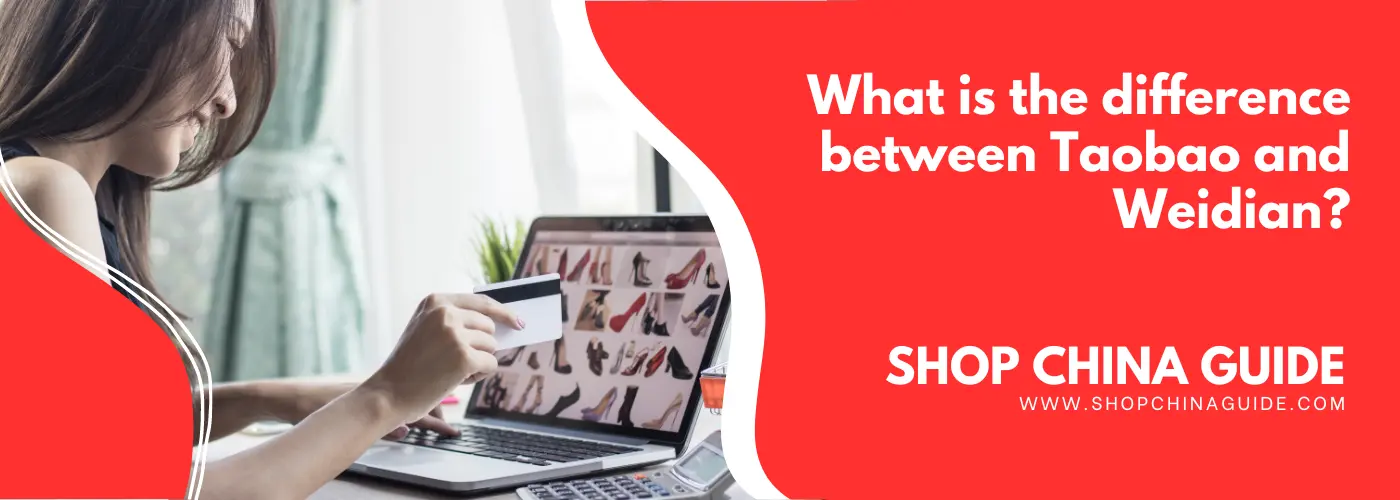In the realm of e-commerce, China has consistently spearheaded innovation. Various models of acclaimed e-commerce platforms have taken root, such as Taobao, a seasoned platform under the renowned Alibaba Group, and JD.com, well-respected for its reliable product quality and swift express delivery. Another emerging player is Weidian, launched in January 2014, now boasting nearly 90 million small and micro shopkeepers. This platform leverages the power of social commerce and thrives as a community driven by the interests of its users.
Today, let’s explore the distinctions between Taobao and Weidian.
Platform Overview: Taobao vs Weidian
Taobao: The Online Marketplace Giant

Taobao, owned by the Alibaba Group, is one of the largest online marketplaces in the world. It’s a platform where millions of businesses and individual entrepreneurs offer a vast array of products. Its immense size, extensive product range, and broad customer base give it a remarkable presence in China’s e-commerce landscape.
Key Taobao Features:
- Large user base: Millions of active users.
- Vast product range: Offers a wide variety of products across multiple categories.
- Advanced search capabilities: Enables customers to find exactly what they’re looking for.
- Integrated payment system: Uses Alipay for seamless transactions.
You may also like: Why are Prices on Taobao Remarkably Affordable? (9 Reasons)
Weidian: The Social Commerce Contender

Weidian is a relatively new player in the e-commerce arena. It’s a mobile commerce platform that allows businesses and individuals to create online stores directly within WeChat, the widely-used messaging app. Weidian leverages the power of social commerce, focusing on ease-of-use, and personalization.
Key Weidian Features:
- Social integration: Deeply integrated with WeChat, allowing for a more social shopping experience.
- Easy setup: Facilitates quick and straightforward store setup for businesses and individuals.
- Mobile-first: Designed primarily for mobile usage.
- Diverse payment options: Supports various payment methods including WeChat Pay.
User Base: Weidian vs Taobao
Taobao: A Mass Market Platform
As one of the biggest e-commerce platforms globally, Taobao boasts a significant user base, with millions of daily active users. These users span across various age groups, professions, and regions, making Taobao a genuinely mass-market platform.
- Taobao Users:
- Size: Enormous – millions of active users.
- Demographics: Diverse – spans across various age groups and professions.
- Geographical distribution: Broad – popular across China and expanding internationally.
Weidian: A Mobile and Socially Engaged Audience
Weidian, being a mobile-centric and socially integrated platform, has a different user base profile. It has a considerable number of users, albeit not as large as Taobao’s, but it tends to attract younger and more socially-engaged audiences.
- Weidian Users:
- Size: Large – hundreds of thousands of active users.
- Demographics: Young and socially engaged – heavily favored by younger generations and those with high social media engagement.
- Geographical distribution: Concentrated – highly popular among urban areas with high smartphone penetration.
Product Variety and Quality: Taobao vs Weidian
Taobao’s product offering is nothing short of astounding, featuring a dizzying array of items across a broad spectrum of categories. Whether you’re in the market for clothing, electronics, furniture, or even exotic pets, chances are, you’ll find it on Taobao. However, this vast selection also means a varied range in product quality. Taobao has systems in place to help ensure the quality of goods sold, including seller ratings and customer reviews, but due to its immense size, the quality can still be inconsistent.
- Taobao’s Products:
- Variety: Extremely broad – millions of different items available across all categories.
- Quality: Varied – products range from low-end to high-end, with inconsistent quality control.
Weidian: Niche, Quality, and Socially-Driven
Weidian, while not offering as wide a product range as Taobao, tends to focus more on niche markets. Here, you’ll find a host of unique, customized, and artisanal products often not found in larger platforms. This focus on smaller, specialized sellers often results in better product quality control.
- Weidian’s Products:
- Variety: More niche – fewer items but with a focus on unique, customized, and artisanal products.
- Quality: Generally high – strong focus on quality due to a high proportion of small, specialized sellers.
Transaction and Payment Methods: Taobao vs Weidian
Taobao: Seamless Transactions with Alipay
In Taobao, transactions occur directly within the platform, providing a consistent and secure shopping experience. To facilitate these transactions, Taobao primarily uses Alipay, one of China’s most popular digital payment services. This integration provides users with an efficient and secure payment process.
- Taobao Transaction and Payment:
- Transaction method: Integrated within the platform.
- Supported payment methods: Primarily Alipay, along with other selected methods.
Weidian: Integrated Social Transactions with Multiple Payment Options
Weidian, as a part of the WeChat ecosystem, takes advantage of its social integration. Users can make purchases directly within the platform. Weidian supports various payment options, including WeChat Pay, making it easy for WeChat’s vast user base to shop on Weidian.
- Weidian Transaction and Payment:
- Transaction method: Integrated within WeChat.
- Supported payment methods: Various, including WeChat Pay.
User Interface and Experience: Taobao vs Weidian
Taobao: Comprehensive but Complex
With its broad product range and extensive user base, Taobao’s interface is comprehensive and feature-rich. It provides advanced search capabilities, recommendations, and personalization based on the user’s browsing history. However, this abundance of features can sometimes result in a steep learning curve, particularly for new users or those unfamiliar with such comprehensive platforms.
- Taobao User Interface and Experience:
- User Interface: Comprehensive and feature-rich, but can be overwhelming for new users.
- User Experience: Personalized recommendations based on user behavior, but can be complex to navigate.
You may also like: How Do Taobao App and Taobao Lite Compare?
Weidian: Simplified and Socially Integrated
Weidian, in contrast, provides a simpler, more streamlined user interface. As a mobile-first platform integrated with WeChat, it caters to a user base already familiar with the social media app’s interface. This results in a user experience that’s easy to navigate, but may lack the depth and breadth of features found on larger platforms like Taobao.
- Weidian User Interface and Experience:
- User Interface: Simple and streamlined, easy for new users to grasp.
- User Experience: Integrated with the familiar WeChat interface, but lacks the extensive feature set of larger platforms.
Future Trends
Weidian and Taobao Influencing Factors
Several factors could influence the future development of these two platforms. For one, policy changes, particularly in terms of data privacy and e-commerce regulations, could significantly impact the platforms’ operation and growth. Both Taobao and Weidian will need to adapt to these changes swiftly and efficiently.
Technological advancements also play a vital role. Developments in areas like artificial intelligence, machine learning, and augmented reality can offer new opportunities for enhancing user experience, personalization, and product discovery.
Additionally, changes in user behavior and market trends, such as increasing demand for sustainable products or the rise of live-streaming commerce, will also shape the platforms’ future strategies.

